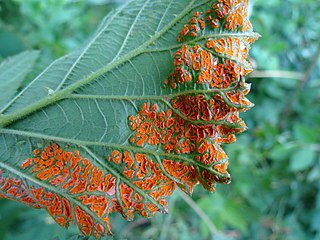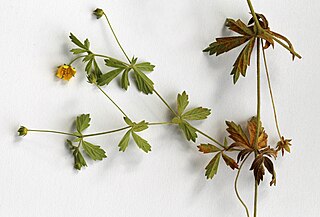Related Research Articles

Basidiomycota is one of two large divisions that, together with the Ascomycota, constitute the subkingdom Dikarya within the kingdom Fungi. Members are known as basidiomycetes. More specifically, Basidiomycota includes these groups: agarics, puffballs, stinkhorns, bracket fungi, other polypores, jelly fungi, boletes, chanterelles, earth stars, smuts, bunts, rusts, mirror yeasts, and Cryptococcus, the human pathogenic yeast.

In biology, a spore is a unit of sexual or asexual reproduction that may be adapted for dispersal and for survival, often for extended periods of time, in unfavourable conditions. Spores form part of the life cycles of many plants, algae, fungi and protozoa.

Rusts are fungal plant pathogens of the order Pucciniales causing plant fungal diseases.

Teliospore is the thick-walled resting spore of some fungi, from which the basidium arises.

The Pucciniaceae are a family of rust fungi that cause plant diseases, mainly on cereals such as wheat. The family contains over 4900 species: many of them in the type genus Puccinia.

The Fungi of Australia form an enormous and phenomenally diverse group, a huge range of freshwater, marine and terrestrial habitats with many ecological roles, for example as saprobes, parasites and mutualistic symbionts of algae, animals and plants, and as agents of biodeterioration. Where plants produce, and animals consume, the fungi recycle, and as such they ensure the sustainability of ecosystems.

Puccinia is a genus of fungi. All species in this genus are obligate plant pathogens and are known as rusts. The genus contains about 4000 species.

Julius Oscar Brefeld, usually just Oscar Brefeld, was a German botanist and mycologist.

Uromyces is a genus of rust fungi in the family Pucciniaceae. The genus was described by Franz Unger in his 1833 work Die Exantheme der Pflanzen. They have a worldwide distribution but large occurrences happen in North America and Europe.

The Auriculariales are an order of fungi in the class Agaricomycetes. Species within the order were formerly referred to the "heterobasidiomycetes" or "jelly fungi", since many have gelatinous basidiocarps that produce spores on septate basidia. Around 200 species are known worldwide, placed in six or more families, though the status of these families is currently uncertain. All species in the Auriculariales are believed to be saprotrophic, most growing on dead wood. Fruit bodies of several Auricularia species are cultivated for food on a commercial scale, especially in China.
Vladimir Andreevich Tranzschel was a botanist, mycologist and plant pathologist, especially an expert on rust fungi. He lived in the Russian Empire and then in the Soviet Union.
The Mikronegeriaceae were a family of rust fungi in the order Pucciniales: now incorporated into the Zaghouaniaceae. The family contained 4 genera and 13 species.

Arthuriomyces is a genus of rust fungi in the family Phragmidiaceae. The genus contains three species that are found in North America, Russia, China, and Japan. The genus is named in honor of American botanist Joseph Charles Arthur, noted for his research on rust fungi.

Frommeella (Frommeëlla) is a genus of rust fungi in the family Phragmidiaceae. The widespread genus contains two species.

Botryorhiza is a genus of rust fungi in the family Zaghouaniaceae. The genus, previously placed in the Chaconiaceae, is monotypic, containing the single species Botryorhiza hippocrateae, which grows on Hippocratea plants in Brazil and the Caribbean.

Chrysomyxa is a genus of rust fungi in the family Coleosporiaceae. The genus, widespread in the Northern Hemisphere, contains about 23 species. Rust fungi in the genus Chrysomyxa occur in boreal forests of the northern hemisphere on Pinaceae,, and most species alternate to angiosperm hosts in the Ericaceae.

Uromycladium is a genus of rust fungi in the family Pileolariaceae. It was circumscribed by mycologist Daniel McAlpine in 1905. The genus was established by McAlpine for rusts on Acacia with teliospores that clustered at the top of a pedicel.
Pucciniosira is a genus of rust fungi belonging to the family Pucciniosiraceae.

The Zaghouaniaceae are a family of rust fungus genera, some of which have long been considered incertae sedis in the order Pucciniales, based on the type genus Zaghouania. The classification of fungal taxa based on only morphological characteristics has long been recognised as problematical, so this order was reviewed over a long-term study using three DNA loci and published in 2021.
References
- ↑ Aime, M. C.; McTaggart, A. R. (2021). "A higher-rank classification for rust fungi, with notes on genera". Fungal Systematics and Evolution. 7: 21–47. doi:10.3114/fuse.2021.07.02. PMC 8165960 . PMID 34124616.
- ↑ Kirk PM, Cannon PF, Minter DW, Stalpers JA (2008). Dictionary of the Fungi (10th ed.). Wallingford, UK: CABI. p. 5. ISBN 978-0-85199-826-8.